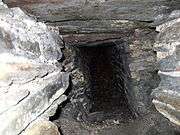Llanfyrnach
Llanfyrnach (![]()
| Llanfyrnach | |
|---|---|
 Parish church of St Brynach, Llanfyrnach | |
 Llanfyrnach Location within Pembrokeshire | |
| OS grid reference | SN2195331195 |
| Community | |
| Principal area | |
| Ceremonial county | |
| Country | Wales |
| Sovereign state | United Kingdom |
| Postcode district | SA35 |
| Dialling code | 01239 |
| Police | Dyfed-Powys |
| Fire | Mid and West Wales |
| Ambulance | Welsh |
| UK Parliament | |
Llanfyrnach village is in a remote upland area on the headwaters of the River Tâf, about 11 miles (18 km) from Cardigan.
History
The parish of Llanfyrnach was in the ancient Cantref of Cemais.[1] There is a small Norman motte close to the church. Llanfyrnach (as Llanvurnach) appears on a 1578 parish map of Pembrokeshire.[2] Much of the parish was unenclosed moorland until the start of the 19th century. Population doubled as numerous small farms were established following enclosure from the 16th century onwards.[3]

There was an important lead mine on the north side of the village until the end of the 19th century. Mining occurred on a small scale for the sake of the low but significant concentration of silver in the ores, perhaps from as early as the 16th century. As a result of high demand for lead in the Victorian era, the mine was greatly extended in the 1840s, and had reached 520 m below the surface by the time of its closure in 1890.[4]
The Whitland & Taf Vale Railway reached the village in 1873,[5] and the village became a transport depot for the surrounding hill country; lead and agricultural produce were shipped out, and heavy supplies, notably lime, were brought in. Although the railway closed in 1963, the village is still a transport hub with Mansel Davies, the road haulage company, based in the village[6] since 1900; the firm was the subject of an S4C documentary in 2017.[7]
The Celtic Blue Rock festival was held at Trefawr Farm in the village,[8] but lost its licence in 2010.[9]
St Brynach's Church
The present church is mid-Victorian, but there has been a Christian community in the village since at least the 6th century when St Brynach is believed to have come to the area. The parish includes a number of other settlements, particularly the village of Crymych and the hamlets of Glandwr and Pentre Galar.[10][11] In 1872 the parish covered 6,328 acres (2,561 ha).[12]
Demographics
The village remains small, with much of the workforce employed in transportation. The population of the parish was 542 (1801), 933 (1851), 954 (1901), 844 (1951) and 837 (1981).[3] The area remains largely Welsh-speaking; the proportion of Welsh speakers was 100% in 1891, 97% in 1931 and 82% in 1971.
Notable people
The Welsh language poet Thomas Evan Nicholas (Niclas y Glais) was born in Llanfyrnach in 1878.
See also
- Llanfyrnach Rural District, historic local government area abolished in 1934
References
- "GENUKI: Llanfyrnach". Retrieved 2 July 2014.
- "Penbrok comitat". British Library.
- "Llanfyrnach CP/AP through time". Retrieved 2 July 2014.
- Claughton, Peter (1999). Llanfyrnach Mine (with further references). Exeter University. Retrieved 2 July 2014.
- Jones, R Emrys (1979). Rheilffyrdd Cymru. Argraffdy Arfon. p. 54. ISBN 0-85365-922-2.
- "Top 100 companies in south west Wales". South Wales Evening Post. 24 September 2014. Retrieved 3 May 2015.
- Thomas Sinclair (5 January 2017). "New S4C documentary focuses on Pembrokeshire company". Pembrokeshire Herald. Retrieved 25 July 2019.
- "BBC News". Retrieved 22 April 2015.
- "Celtic Blue Rock festival loses licence over safety fears". WalesOnline. 20 May 2010. Retrieved 3 May 2015.
- "Llanfyrnach Church". Retrieved 2 July 2014.
- "GENUKI: Llanfyrnach parish map". Retrieved 16 August 2019.
- Wilson, J.M. (1872). Imperial Gazetteer of England and Wales 1870-72. Retrieved 2 July 2014.
| Wikimedia Commons has media related to Llanfyrnach. |
External links
- Photographs of Llanfyrnach and surrounding area on Geograph
- July 2014 Further historical information and sources on GENUKI
| Preceding station | Historical railways | Following station | ||
|---|---|---|---|---|
| Rhydowen | Great Western Railway Whitland & Cardigan Railway |
Glogue | ||